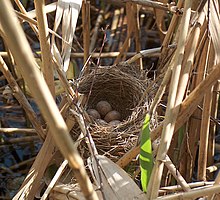Great reed warbler
Great reed warblers exhibit relatively low sexual dimorphism, and both sexes of the species are similar in appearance.
The song's main phrase is a chattering and creaking carr-carr-cree-cree-cree-jet-jet, to which the whistles and vocal mimicry typical of marsh warblers are added.
It does not breed in Great Britain - where it is replaced by the closely related common reed warbler, Acrocephalus scirpaceus - but is an irregular visitor.
[1][8][9] While there are no subspecies of this bird, mtDNA haplotype data indicate that during the last glacial period there were two allopatric populations of great reed warbler.
The great reed warblers in southwestern and southeastern Europe were at that time apparently separated by the Vistulian-Würm ice sheets and the surrounding barren lands.
[9] During 2017–2019, miniature data loggers were used to track migratory flights of great reed warblers, over the Mediterranean Sea and Sahara Desert, between their breeding grounds at Lake Kvismaren, Sweden, and their winter quarters in sub-Saharan Africa.
Possible explanations for such high--altitude ascents include avoidance of predation, reduction of risk of hyperthermia and dehydration, and extension of the visual horizon.
The great reed warbler undergoes marked long-term population fluctuations, and it is able to expand its range quickly when new habitat becomes available.
[1][9] Population size can be calculated with a suitability model, but direct counts of territorial males in suitable habitat and sampling the population sex-ratio can be a proper alternative to inference-rich predictive modeling based on imperfect habitat-extrapolation of densities of reed warblers at large spatial scales.
Observation of prey collection specifically during breeding season has shown the retrieval of insect larvae, moths, dragonflies, damselflies, beetles, spiders, small fish, and frogs.
The great reed warbler is a notable example of these selective pressures, as it is a partial polygynist and has evolved variable song structure (both long and short) through evolutionary compromise.
[17] In addition to communication, the great reed warbler's song size has been implicated in organism fitness and reproductive success.
In addition, male song repertoire length is positively correlated to annual harem size and overall lifetime production of offspring that survive.
They defend large territories in reed beds where there is reduced visibility, which may allow males to practice deception by moving and attracting a second female.
Models based on the polygyny threshold and sexy son hypotheses predict that females should gain evolutionary advantage in either short-term or long-term in this mating system, yet the study did not support this.



